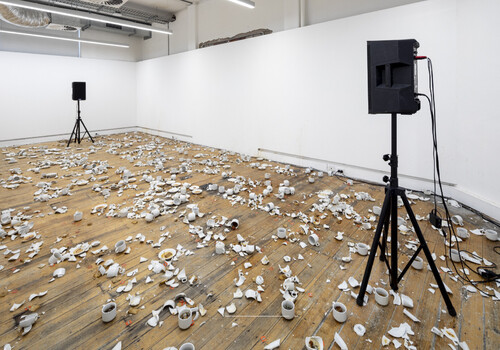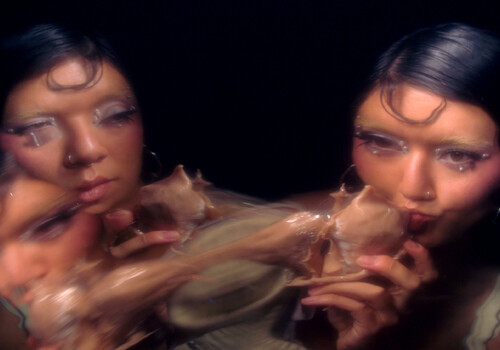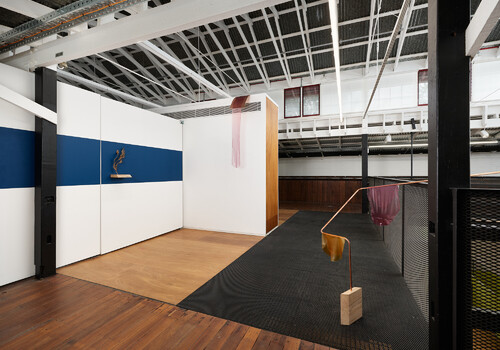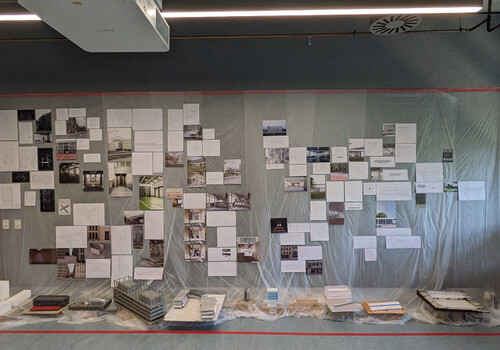Bachelor of Fine Art (Honours), Monash Art, Design and Architecture
By Ned Dwyer
I stare at the rabbit and the rabbit stares back. Not at me, but through me. It’s captivated by the copper-leaf lobster that hangs ominously behind us. Emmica Lore’s two-part installation, lobster and bunny (2024), is the shiniest thing in the Monash Honours exhibition.

Emmica Lore, bunny, 2024, Styrofoam, pins, sequins, plywood, imitation copper leaf, chain. Photo: Andrew Curtis.
bunny is on a platform suspended from the ceiling by silver chains and is painstakingly pinned with hundreds of salmon-coloured sequins. They give me the vaguely chilling impression of flayed game—or a Cadbury easter egg. It contrasts with the wall-mounted lobster, which is smothered in gilt, beaming like the Rucellai and upright like the crucifix. An icon in three-dimensional space. Together, they are the earthly and the divine, the former bent meekly in worship of the latter.

Emmica Lore, lobster, 2024, Styrofoam, imitation copper leaf, temporary tattoos. Photo: Andrew Curtis.
Lore deifies the lobster, but it is far from a laudation. The lobster-Christ is smattered with kitschy little temp tats, kittens, roses, and (my favourite) a gothic font “angel” at the base of its abdomen. That’s a lobster tramp-stamp for those who are keeping up with their crustacean anatomy, and it raises some interesting questions about lobster-Christ’s hobbies. The tattoos are haphazard, and they remind me of graffiti tags. They have the gleeful smack of iconoclasm, the sacred wrought irreverent by way of deviancy. Its pearl-grasping stuff.
But there is trickery afoot—the gilt is imitation, the tattoos are temporary, and the rabbit is not a rabbit. The two sculptures are actually jelly moulds in the shape of their respective animals, exoskeletons implying their own mushy “underneaths.” There is a power to the otherwise innocuous forms, the shells uneven and somewhat uncomfortable. The contortion of this surface exposes its true intention of shaping, constraining, moulding, and subjectifying. I wrestle not with lobsters and rabbits, but powers and principalities. The moulds shimmer deceptively.

Emmica Lore, lobster and bunny, 2024, Styrofoam, pins, sequins, plywood, imitation copper leaf, chain, temporary tattoos. Photo: Andrew Curtis.
Another Foucauldian struggle is happening down the hall with Leon Rice-Whetton’s impasse. I am summoned in by the diegetic tinkling of its quadraphonic speakers. To the right, separated by a black wall, a single screen of Perspex is illuminated by a projector. I’m caught like a rabbit in the lobster-lights, which seems to be the idea. A chair is provided for the contemplative, so I sit.
[stock bridge] depicts a nearly motionless video of a concrete path hemmed in by construction fences. It is tightly framed, the artificial barricades funnelling me down a predetermined route that slouches up to the horizon. The screen is held up by star-cross pickets and fence feet, turning it into another of so many walls. I’m alone, my lambent companion keeping hush in the cave-like dark. Rice-Whetton hits on the indifference of force in everyday life, a banal assortment of construction materials rendered imposing by cool impassivity. Signs of life are obscured. Even the projector is cagily hidden behind the Perspex, shining back towards me. The image itself is an inversion (a bastardisation?) of the true video, a Platonic joke at my expense.

Leon Rice-Whetton, [stock bridge] in impasse, or, commencing at the south corner of allotment twenty-nine at a stake on the east bank of the Saltwater River, 2024, Perspex, c-stands, star pickets, concrete, plaster, timber, single-channel video, stereo audio, 24 minutes looped. Photo: Andrew Curtis.
The tour ends where it begins, as I stagger hoodwinked back to Lore’s moulds. I crouch behind the platform to get one last chance at a rabbit POV. We stare at the lobster and the lobster doesn’t care.
Ned Dwyer is a graduate law student at the University of Melbourne.









































